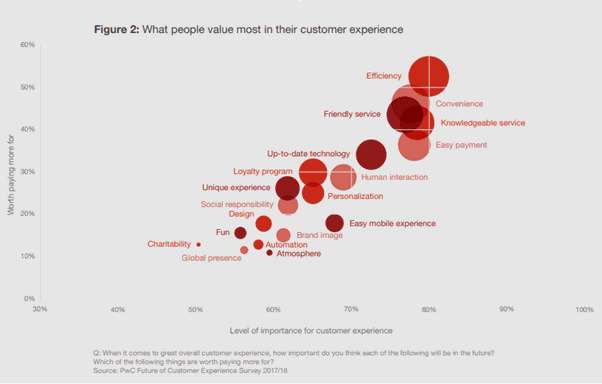Your customer service team is on the front line of your business, which means should do everything you can to make their work easier. They can make the difference in retaining or losing a sale, so it makes sense to provide them with the right tools.
VoIP phone systems are a business tool that can add value to every customer interaction.
Here’s why every customer service team should be using VoIP.
The Customer is Key
Customers are vital. They’re the lifeblood of any business. So keeping customers happy should be the number one priority for every business. Customers stay with a company that serves them well and, when they’re happy and succeeding, they’ll often refer your business to others.
According to a study by Walker, by 2020 customer service will have overtaken price and product as the number one factor for business success.
Efficiency, convenience, friendly service, knowledgeable service, and easy payment scored highly in a PwC survey of what customers value most. A staggering 73% of people said customer experience was an important factor in their buying decisions which greatly reflects the cost of poor customer service.

Meeting Increased Customer Expectations
Customers’ expectations of support services have increased dramatically. Customers now expect a business to be online 24 hours a day. They are also increasingly impatient about getting what they want, when they want it.
VoIP phones allow a company to outsource customer support to anywhere in the world. Whether the team is in a contact center or working from home, it doesn’t matter to the customer – they use the same telephone number regardless. A customer can dial a local number and be connected to a team member wherever they are.
Outsourcing opens up the opportunity for 24/7 customer service. A business can achieve 24-hour service by spreading out the workforce across time zones. Keeping a workforce fresh in this way helps provide a friendlier, more helpful service.
The Mehrabian formula for communication says that the meaning conveyed in a conversation is:
- 7% actual words
- 55% facial expression
- 38% tone of voice
On the phone, the facial expression is a moot point – but the tone of voice is vital. A relaxed and happy employee will convey their feelings on a call to the customer with a friendly tone of voice. A cheerful employee helps the customer relate to them and the company too. How can a team be relaxed when there is a high volume of calls?
No Call Goes Unanswered
If the target is that no call goes unanswered, VoIP networks can help you reach that goal. VoIP systems can be set up to forward calls to external agencies, allowing companies to spread out the work across the world.
Phones can be set up to offer the customer a call back when no agents are available. Call back services are a popular option that reduces voicemail, which is time-consuming for customers and team members. The Gap Partnership suggests that you should never leave a caller on hold for longer than 20-30 seconds without offering a callback.
The VoIP phone system can also try multiple numbers at once, so the customer can be put through to another that has availability if one employee or team is over-reached. By forwarding calls to other employees, a customer can reach a real person and receive support quickly. Reducing wait times contributes to a reduction in customers who give up, hang up, and don’t return.
Reducing Wait Times
The global average wait time, according to TalkDesk, is 1.5 minutes for finished calls and 4 minutes for abandoned calls.
Interestingly, adding on-hold music can increase the amount of time that a caller is prepared to wait. The reason for their increased patience is that their perception of the time spent is lower when listening to music. On-hold music is a standard feature of VoIP systems.
Another standard feature of VoIP is caller ID. Integration with a CRM can further enhance caller ID with a complete history of the customer, including order information and any recent issues. Calling a customer by name can increase customer rapport, according to Onsip. Access to the customer’s history can help a support team to put calls through to the right person quickly.
More Efficient Interactions with Customers
“One of the most common customer complaints about contact centers is that the customer has to repeat their problem to multiple agents,” says Paul Faust, SVP of Business Development and a partner at RingBoost.
Calling up information for a customer is a quick process if connections between the phone system and the CRM exist. Access to customer notes can stop the annoying cycle of being put through to person after person and having to repeat the same information over and over again.
Visual communication can help users to understand complex information quickly. The app allows you to share video from your free screen recorder, add notes to screengrabs, and demonstrate a product feature or issue solution. People demand immediate, easy to comprehend communication, and video is one of the simplest ways to get the job done.
When a customer can see the information, they often understand it better. Interaction with a customer can also be personalized and result in a customer feeling like they have been listened to and understood.
Better Quality at Lower Cost
The clarity of VoIP phone calls is excellent and has improved considerably over the years. The improved experience is due to a broader frequency range than is available to analog phones. However, call clarity is directly related to broadband quality, so a business-class broadband connection that prioritizes voice over data is required to achieve the best quality. A bonus is that this improvement in service does not come at a higher cost.
VoIP phone systems are cheaper to install, and call costs are lower, than traditional wired phone services. According to IT World, “Switching to VoIP can save small businesses as much as 45 percent each month over traditional phone service.” They attribute some of this cost-saving to a reduction of maintenance and the ease of adding new lines when required. But the savings do not end there, as VoIP also reduces the number of lines needed and can improve efficiency in business processes.
Improve Business Processes
Managers need the right tools to improve processes and measure the effectiveness of your customer service approach. VoIP gives them these tools. Call queue dashboards provide a manager with an overview of the customer service team at a glance. The report can be configured to suit the business.
From their VoIP dashboard, a manager can view the following information:
- the number of calls answered
- callers who hung up
- duration of a call
- average speed of answer (ASA)
For example, a commonly-used industry standard is that calls must be answered within 20 seconds or less at least 80% of the time. Notifications can be sent to a manager when call volume increases or the number of unanswered calls goes over the limit. This information can help a manager assess staffing requirements and shift allocation.
Employees Drive the Customer Experience
With VoIP, managers have the option to monitor employees. A manager can listen in on a conversation, and provide hints to the team member without the customer hearing them. In some cases, a manager will need to enter the conversation and can converse with both the team member and the customer. These features enable easier escalating of calls and prompt resolution of issues.
Call recording allows a manager to review a call with an employee and make suggestions for improvements. A call recording or transcription might also become part of training documentation if a team member has done particularly well.
Employees drive the customer experience. According to PwC, over 60% of respondents to their survey gave bad employee attitude and unfriendly service as the reason they took their money elsewhere. Customers also only gave a company one chance, with 32% saying they will walk away from a brand they love after just one bad experience. For that reason alone, using the valuable data that you get from switching to a VoIP system to train and enable staff to provide better customer experience makes perfect business sense.
Why Customer Service Teams Use VoIP
Improving your customer experience will have a beneficial effect on your bottom line, period. Bad customer experience or long wait times will make customers take their business to another provider. A company can improve the service it provides by answering calls on time, answering customer queries efficiently, and training employees to be customer service heroes.
All these improvements are possible with, and can be enhanced by, the use of VoIP for your customer service team.
Sam O’Brien is the Senior Website Optimisation & User Experience Manager for EMEA at RingCentral, a global UCaaS systems provider. Sam has a passion for innovation and loves exploring ways to collaborate more with dispersed teams. He has written for websites such as BambooHR and Vault.
